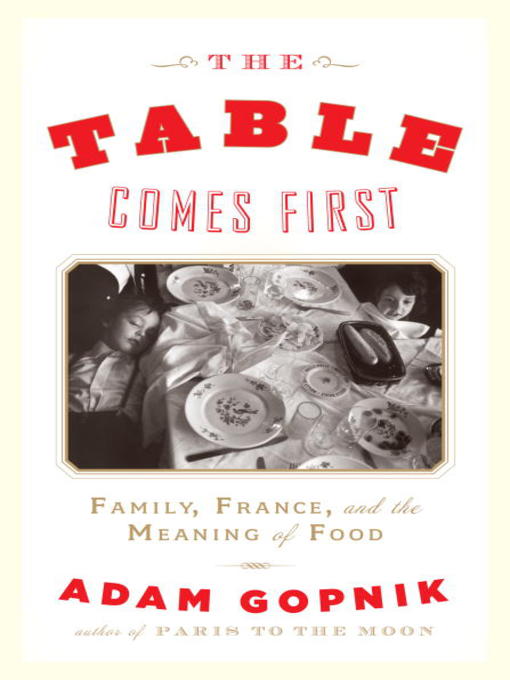Never before have so many North Americans cared so much about food. But much of our attention to it tends towards grim calculation (what protein is best? how much?); social preening ("I can always score the last reservation at xxxxx"); or graphic machismo ("watch me eat this now"). Gopnik shows we are not the first food fetishists but we are losing sight of a timeless truth, "the table comes first": what goes on around the table matters as much to life as what we put on the table: families come together (or break apart) over the table, conversations across the simplest or grandest board can change the world, pain and romance unfold around it—all this is more essential to our lives than the provenance of any zucchini or the road it travelled to reach us. Whatever dilemmas we may face as omnivores, how not what we eat ultimately defines our society.
Gathering people and places drawn from a quarter century's reporting in North America and France, The Table Comes First marks the beginning a new conversation about the way we eat now.
-
Creators
-
Publisher
-
Release date
October 25, 2011 -
Formats
-
OverDrive Read
- ISBN: 9780307399038
-
EPUB ebook
- ISBN: 9780307399038
- File size: 2318 KB
-
-
Languages
- English
-
Reviews
-
Publisher's Weekly
September 12, 2011
By turns ponderous and amiable, recherché and playful, Gopnik’s (The Steps Across the Water) look at the changing rituals of eating and cookery is thorough and rarely dull. Drawing heavily from his stints living in France, and having become the professed “cooking husband” in his family, Gopnik has grown intensely interested in “questions of food” and how the way we eat reflects the changing state of our civilization. He explores the rise of restaurants in Paris before the Revolution as rest stops offering restorative bouillon and places where women could even appear alone. Along with the growth of restaurants in the Palais Royal emerged food writers like Brillat-Savarin (Physiology of Taste), and cookbook manuals such as Gopnik’s favorite, the recondite Diary of a Greedy Woman by the late–19th-century English writer Elizabeth Pennell—all the while sharing his own cooking “secrets.” Distinctions between “mouth taste” and “moral taste” have grown increasingly urgent, since the slow food movement embraces localism, sustainability, and “peasant food,” and Gopnik sermonizes rather tautologically on how fashions can change when people change their values. He takes up the debate between meat eating versus vegetarianism, concocts a meal in New York City using only local products (even a Bronx-bred chicken), faces down the wine connoisseurs, and visits plenty of chefs on both sides of the Atlantic for ideal dishes. -
Publisher's Weekly
January 2, 2012
Longtime New Yorker contributor Adam Gopnik charts the rise and evolution of America’s obsessive foodie culture, tracing the roots of “eclectic eating in big cities” back to French manners, describing how the emergence of restaurants affected social norms, and chronicling his own culinary adventures and misadventures in both the United States and Europe. Gopnik is an enthusiastic reader, especially when describing his own experiences, e.g., the wariness in his voice is palpable as he embarks on a possibly illicit mission to procure (and consume) a New York–raised chicken. However, Gopnik’s narration is less natural during more academic sections of the book, such as when he attempts to place our relationship with eating in a historical context. In such cases, his reading sounds stilted—as if he’s delivering a lecture from his notes. A Knopf hardcover.
-
Formats
- OverDrive Read
- EPUB ebook
subjects
Languages
- English
Loading
Why is availability limited?
×Availability can change throughout the month based on the library's budget. You can still place a hold on the title, and your hold will be automatically filled as soon as the title is available again.
The Kindle Book format for this title is not supported on:
×Read-along ebook
×The OverDrive Read format of this ebook has professional narration that plays while you read in your browser. Learn more here.

